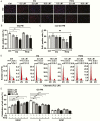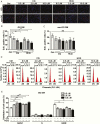Novel Roles of Chloroquine and Hydroxychloroquine in Graves' Orbitopathy Therapy by Targeting Orbital Fibroblasts
- PMID: 32249902
- PMCID: PMC7183395
- DOI: 10.1210/clinem/dgaa161
Novel Roles of Chloroquine and Hydroxychloroquine in Graves' Orbitopathy Therapy by Targeting Orbital Fibroblasts
Abstract
Context: Graves' orbitopathy (GO) causes infiltrative exophthalmos by inducing excessive proliferation, adipogenesis, and glycosaminoglycan production in orbital fibroblasts (OFs). Interference with OF autophagy is a potential therapy for proptosis.
Objectives: Here, we aimed to evaluate the effects of chloroquine (CQ) and hydroxychloroquine (HCQ), the autophagy inhibitors commonly used in clinical practice, on OFs.
Design/setting/participants: OFs isolated from patients with GO (GO-OFs) or control individuals (non-GO-OFs) were cultured in proliferation medium (PM) or subjected to differentiation medium. OFs were treated with CQ or HCQ (0, 0.5, 2, and 10 μM), and subsequently examined in vitro.
Main outcome measures: CCK-8, EdU incorporation, and flow cytometry assays were used to assess cellular viability. Adipogenesis was assessed with Western blot analysis, real-time polymerase chain reaction (PCR) , and Oil Red O staining. Hyaluronan production was determined by real-time PCR and enzyme-linked immunosorbent assay. Autophagy flux was detected through red fluorescent protein (RFP)-green fluorescent protein (GFP)-LC3 fluorescence staining and Western blot analyses.
Results: CQ/HCQ halted proliferation and adipogenesis in GO-OFs in a concentration-dependent manner through blockage of autophagy, phenotypes that were not detected in non-GO-OFs. The inhibitory effect of CQ/HCQ on hyaluronan secretion of GO-OFs was also concentration dependent, mediated by downregulation of hyaluronan synthase 2 rather than hyaluronidases. Moreover, CQ (10 μM) induced GO-OF apoptosis without aggravating oxidative stress.
Conclusions: The antimalarials CQ/HCQ affect proliferation, adipogenesis, and hyaluronan generation in GO-OFs by inhibiting autophagy, providing evidence that they can be used to treat GO as autophagy inhibitors.
Keywords: Graves’ orbitopathy; adipogenesis; autophagy; chloroquine; hydroxychloroquine; orbital fibroblasts.
© Endocrine Society 2020.
Figures





Similar articles
-
Disulfiram Exerts Antiadipogenic, Anti-Inflammatory, and Antifibrotic Therapeutic Effects in an In Vitro Model of Graves' Orbitopathy.Thyroid. 2022 Mar;32(3):294-305. doi: 10.1089/thy.2021.0246. Epub 2021 Dec 31. Thyroid. 2022. PMID: 34605662
-
4-Methylumbelliferone suppresses hyaluronan and adipogenesis in primary cultured orbital fibroblasts from Graves' orbitopathy.Graefes Arch Clin Exp Ophthalmol. 2020 May;258(5):1095-1102. doi: 10.1007/s00417-019-04528-3. Epub 2020 Jan 3. Graefes Arch Clin Exp Ophthalmol. 2020. PMID: 31900640
-
Therapeutic Effect of Guggulsterone in Primary Cultured Orbital Fibroblasts Obtained From Patients with Graves' Orbitopathy.Invest Ophthalmol Vis Sci. 2020 Mar 9;61(3):39. doi: 10.1167/iovs.61.3.39. Invest Ophthalmol Vis Sci. 2020. PMID: 32196098 Free PMC article.
-
Current perspectives on the role of orbital fibroblasts in the pathogenesis of Graves' ophthalmopathy.Exp Eye Res. 2016 Jan;142:83-91. doi: 10.1016/j.exer.2015.02.007. Exp Eye Res. 2016. PMID: 26675405 Review.
-
Orbital Signaling in Graves' Orbitopathy.Front Endocrinol (Lausanne). 2021 Nov 9;12:739994. doi: 10.3389/fendo.2021.739994. eCollection 2021. Front Endocrinol (Lausanne). 2021. PMID: 34899596 Free PMC article. Review.
Cited by
-
Hydroxychloroquine Alleviates EAU by Inhibiting Uveitogenic T Cells and Ameliorating Retinal Vascular Endothelial Cells Dysfunction.Front Immunol. 2022 Mar 25;13:859260. doi: 10.3389/fimmu.2022.859260. eCollection 2022. Front Immunol. 2022. PMID: 35401507 Free PMC article.
-
Graves' Disease and Rheumatoid Arthritis: A Bidirectional Mendelian Randomization Study.Front Endocrinol (Lausanne). 2021 Aug 17;12:702482. doi: 10.3389/fendo.2021.702482. eCollection 2021. Front Endocrinol (Lausanne). 2021. PMID: 34484118 Free PMC article.
-
Autophagy in graves' ophthalmopathy.Front Cell Dev Biol. 2023 Apr 14;11:1158279. doi: 10.3389/fcell.2023.1158279. eCollection 2023. Front Cell Dev Biol. 2023. PMID: 37123414 Free PMC article. Review.
-
The Potential of Artemisinins as Novel Treatment for Thyroid Eye Disease by Inhibiting Adipogenesis in Orbital Fibroblasts.Invest Ophthalmol Vis Sci. 2023 Jun 1;64(7):28. doi: 10.1167/iovs.64.7.28. Invest Ophthalmol Vis Sci. 2023. PMID: 37326592 Free PMC article.
-
A randomized controlled trial on the effect of hydroxychloroquine in mild Graves' orbitopathy (GO-HCQ): study protocol.Trials. 2025 Aug 4;26(1):272. doi: 10.1186/s13063-025-09002-6. Trials. 2025. PMID: 40760017 Free PMC article.
References
-
- Bartalena L, Pinchera A, Marcocci C. Management of Graves’ ophthalmopathy: reality and perspectives. Endocr Rev. 2000;21(2):168-199. - PubMed
-
- Wiersinga WM, Bartalena L. Epidemiology and prevention of Graves’ ophthalmopathy. Thyroid. 2002;12(10):855-860. - PubMed
-
- Sisti E, Coco B, Menconi F, et al. . Intravenous glucocorticoid therapy for Graves’ ophthalmopathy and acute liver damage: an epidemiological study. Eur J Endocrinol. 2015;172(3):269-276. - PubMed
-
- Tanda ML, Bartalena L. Efficacy and safety of orbital radiotherapy for graves’ orbitopathy. J Clin Endocrinol Metab. 2012;97(11):3857-3865. - PubMed
Publication types
MeSH terms
Substances
LinkOut - more resources
Full Text Sources
Other Literature Sources
Research Materials

